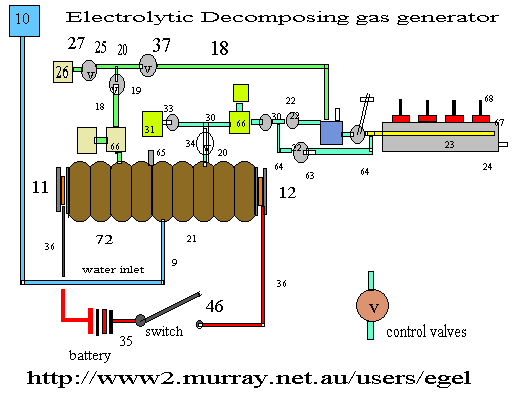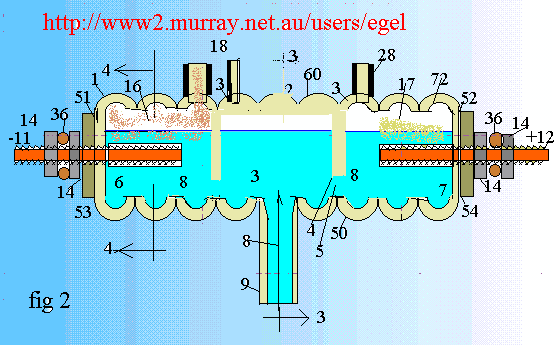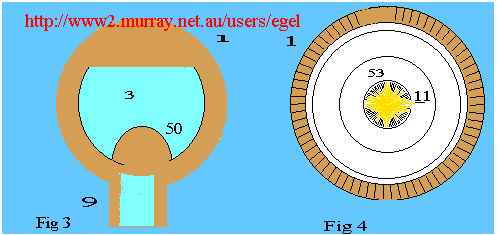
Application June 29 1942 serial number 448,891
Patent April 3 1945 2,373,032
I though this invention needs to be looked at again and may give some ideas for inventors dealing with hdrogen fuels for cars and if it works could be the answer to using hydrogen without the need of safe storage compartments for hydrogen (web page master)
This invention refers to fuels for internal combustion engines and more particularly to be used in decomposing or extracting gases from liquids such as water and then arranging then for use as an explosive mixture in engines of the internal combustion type. It has among its objects to provide a device that will separate combustible gases from the liquid compounds having same chemically combined in them ,as for example :oxygen and hydrogen from water ,through an electrolytic process. Another object is to have the device of such construction as to be readily adaptable for insertion or connection among the parts of a conventional internal combustion engine of the automobile ,airplane ,boat or other type without requiring radical or complicated arrangements for the purpose and capable of practical employment.
A further object is to provide for the operation of the device in a convenient manner with adjustments it to meet varied conditions encountered during operation. A further object is to provide a device that will automatically supply treated water or other liquid medium as needed for the device.
A further object is to have the device adaptable for adjustment by remote control or at a distance from the operator or user. It is a particular object of the invention to construct a self contained unit that can be applied to an internal combustion engine ;and take relatively small space and be attached thereto in a compact and attractive manner.
Other objects will become apparent as the invention is more fully set forth.
There has been difficulty here to fore in employing the combustible gases of relatively inexpensive liquids, such as water, for power development due to the cost of equipment ,its cumbersome nature, and cost of operation. this invention is intended to relieve this situation by providing a simple manner for manufacture of explosive gases by decomposing same from liquids that are normally harmless and inexpensive.
A typical form of internal combustion engine furnished to propel an automobile, aircraft, boat or the like has fuel tank, carburetor, ignition.
The fuel consists of gasoline or other hydrocarbon that runs from the tank to the carburettor, a current of air is drawn over the liquid and takes up the vapour and mixes the later to form an explosive mixture, to operate the internal combustion engine. This system has been found satisfactory as long as sufficient as a sufficient supply of gasoline or other fuel oil was available to meet it needs. Under present conditions the demand has increased and far exceeds supply. Any additional system of fuel production that will be less costly and can use ingredients that can be found readily at hand and not here to before used for the purpose herein described affords attractive possibilities. In this invention the fuel tank is filled with water to which has been added an electrolyte, usually sulphur trioxide or sulphuric acid to increase its conductivity so an electric current will pass through it. The fluid is then passed from the tank to the generating device by a pump, vacuum tank ,gravity or whatever system for the fuel supply the vehicle may be equipped with. The device is preferably placed between the fuel tank and engine and used with existing carburettor. The device can be placed in the system conveniently as it takes little room, is of simple form and has effective arrangement for attachment to the system. An important feature of the device is in the fact that it has arrangements for augmenting the supply of gas generated by the device. Another important feature of the device is that part of the gas generated may be used to replenish its respective auxiliary tube.
In the drawing which indicates a form of this invention.



Similar reference characters refer to similar parts through the drawing.
In the drawing which indicates a water generator 1 by way of example, a source of electricity 35 is employed for converting the water into oxygen and hydrogen gases. The generator is preferably of hollow cylindrical form, with its upper wall supporting partitions 3 dividing the interior into two compartments 6 and 7 respectively and with an intermediate chamber 60. A space 4 is left between the lower portion 58 of the partition and the floor 5 of the generator as indicated in figure 1. The liquid 8 is to be processed in conducted to the bottom wall 5 into the generator through a pipe 9 connected with the liquid reservoir tank 10. The end portions of the generator have screw threaded holes 51 and 52 into which insulators 53 and 54 respectively screw. The insulator 53 holds the negative cathode terminal 11 and insulator 54, the positive anode terminal 12. The insulators and terminals are water tight and are constructed to serve as stuffing boxes. The terminal 11 and 12 project into compartments 6 and 7 respectively and contact the liquid within. Electricity from a suitable source 35 feed the terminals when it is desired to decompose the liquid, which in this instance is water, into component gases oxygen and hydrogen. The water is acidulated with sulphur trioxide (SO2) to improve its conductivity and electrolytic decomposition. The current passing into the water, when the circuit 36 is operating causes hydrogen gas to liberate at the cathode terminal 11 and oxygen at the anode terminal 12. This is usually indicated by bubbles forming and arising from the terminals.
The hydrogen gas collects in the compartment 6 and rises above the water into this space 16 and flows out of the outlet 18 into piping that conducts it to a cylinder when it is stored. Oxygen accumulating at terminal 12 passes into compartment 7 thence through liquid into the space 17 . From thence it passes into the piping 28. The piping is provided with check valves 19 and 34 , fittings 20 and 30, carburettor 22 pipes 21,22,27,33,28 and 39, valves 25,29 and 37 as indicated in the drawing. The internal combustion engine used for the operation is designated as 24 . A by pass connection with conventional accessories indicated to
eliminate the carburettor aw may be required at any time. the hook up comprises valves 63 and 61 and check valve 62 and pipes 64. The circuit 36 when its switch 46 is closed causes electricity to flow the acidulated water from anode 12 to cathode 11. This breaks up molecules of water into hydrogen and oxygen. The hydrogen arises from the cathode 11 into space 16 in chamber or compartment 6 and the oxygen from the anode terminal 12 into the compartment 7; The partition 3 serving to keep them apart and segregated.
The space 4 allows the water to move freely from one compartment of the generator to the other. The current also can pass through the water without obstruction by the partition . the partitions however mechanically prevent the hydrogen and oxygen mixing with each other in the generator .Any tendency of either hydrogen or oxygen to stray outside of their respective compartments is prevented by the intermediate chamber 60 which collects them. such stray gases are removable through an outlet pipe 65 ,provided for the purpose . The vibration of the generator under any use in the vehicle mentioned will not be sufficient to mix the gases by reason of the partitions 3 and the intermediate chamber 60 functioning as described. Pumps 66 or other conventional arrangement are utilised in the outlet piping 18 and 29, to force the hydrogen and oxygen respectively out of the compartments 6 and 7 through piping 21 and 39 to the mixer or carburettor 22 on their way to the engine 24 to be ignited by spark plugs 57 and ignition system 68.
The hydrogen and oxygen are preferably combined through the medium of the spark and in doing so explode powerfully. The explosion causes the engine pistons to reciprocate and operate the engine in the usual manner. Low pressure explosions can be induced through a stoichiometric mixture of hydrogen and oxygen at a suitable ignition temperature. Ribs 72 provide expanding mechanical space and prevent the liquid from sloshing back and forth .In the operation of the device the tank 10 is filled with water to which has been added sulphur trioxide or sulphuric acid so increasing its conductivity. The tank is located high enough so that the liquid can run down into the generator. 1 by gravity, or supplied to the gas generator by the fuel pump or other lifting method which then exists in the automobile or other vehicle to which it is applied. The anode terminal 12 is connected to the positive side of an electric battery or other electrical source, and the cathode 11 is connected to the negative side of the electric source. A switch 46 completes the electrical connections and may be placed on the instrument board convenient to the operator.
When the electric source is turned on by switch 46 bubbles will form around the cathode and anode terminals and will arise through the solution and be collected in their respective chambers or spaces. The valve 37 is opened and pump 66 started and allows gas to flow through pipes 21 and check valves 19 into carburettor or other mixing device 22 which is opened or closed by lever 38. Oxygen flows from this space 17 through check valve 34 fitting 30 pipe 28 pump 66 valve 29 and pipe 39 into the carburettor or other mixing device 22 where the hydrogen is properly mixed with air 40 or oxygen to give proper combustion after which the mixed gases are conveyed to the internal combustion engine where they are ignited similarly to present day use of gasoline or fuel oil in internal combustion engines. an auxiliary cylinder 31 of oxygen is attached to pipe 33. valve 32 to supplement the supply of gases developed by the generator ,or may be used when it is desired to remove the generator from the lines for repairs etc. The generator can be constructed compactly and mounted close to the engine. lock nuts 14 provide for adjustments of electrodes and for attachment of electric wires thereto:
The generator itself is preferably of insulating materials such as any well known plastic, in order to increase efficiency of the generator and prevent conducting of electricity to the walls where the action would be slightly short circuiting. The ribbed or corrugated bottom surface 5 serves to create an interruption in the movement of the molecule or ions energised to a breaking point by the electric current flowing from the electrode 12 and 11 respectively. The breaking point is that condition arising just prior to the separation of the water molecules ( or other substances acted upon) into their atoms oxygen and hydrogen. The effect of this curvilinear and obstructing construction seems to be that of a mechanical disturbance or collision to the flow of the ions causing them to collide more easily and to introduce separation of the atoms more quickly than without it. This improves the effectiveness of the generator and increases the efficiency of the process.
The walls of the tank 1 are given their corrugated form inside to reduce the sloshing of the water in the lower portions, whilst the upper surfaces thereof serve to entrap the gases and induce them to deposit their particles of loose water thereon and cause the latter to drip back into the main body of the water. This keeps the escaping gases relatively dry. The partitions 3 serve to co-operate with the corrugations in preventing sloshing and reducing the escape of moisture from the chamber 60 to the chambers 15 and 17. This also diminishes any tendency of the incoming water to appreciably disturb the level of the water in the electrode chambers.
The chamber 60 acts as a cushion device.